












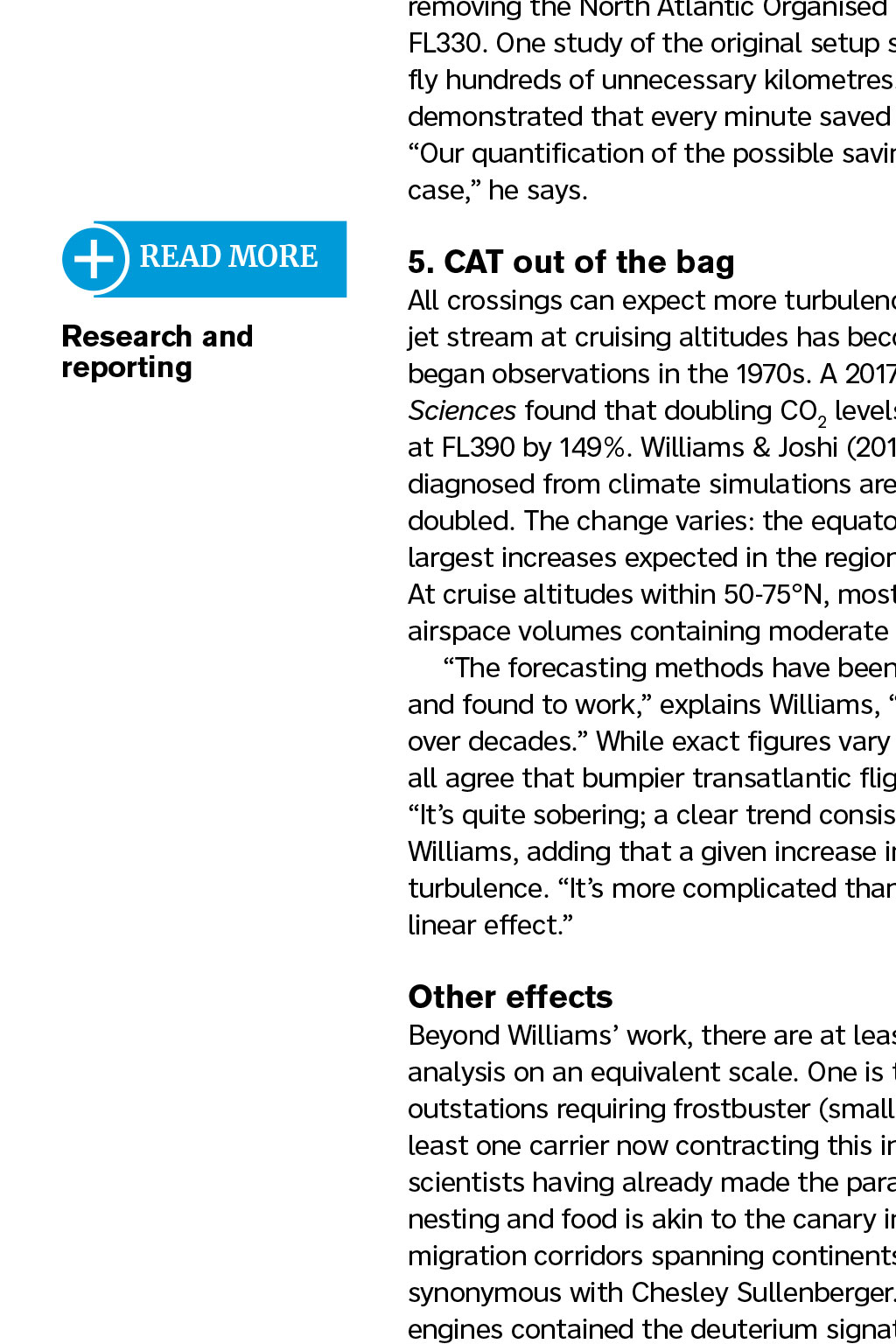
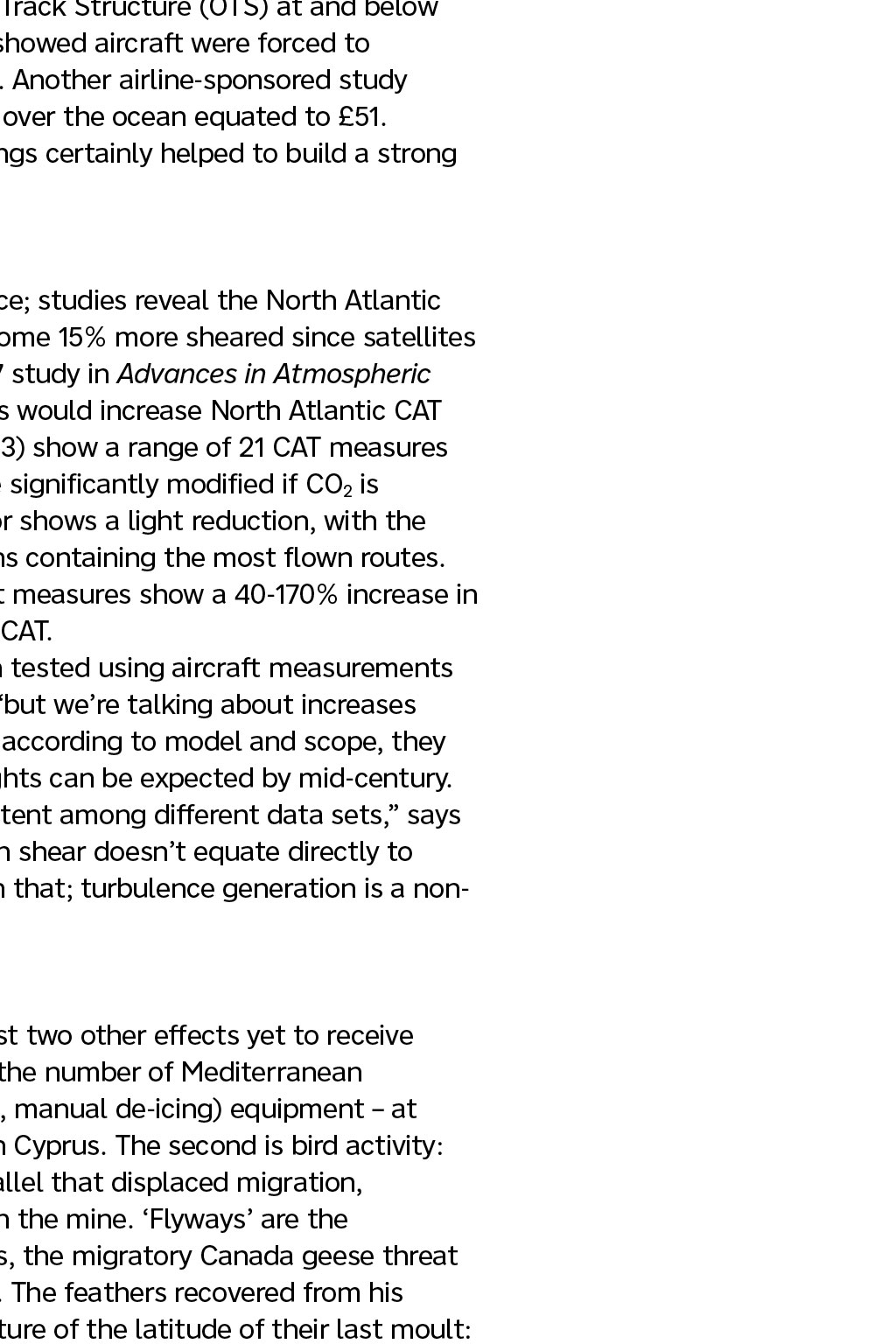
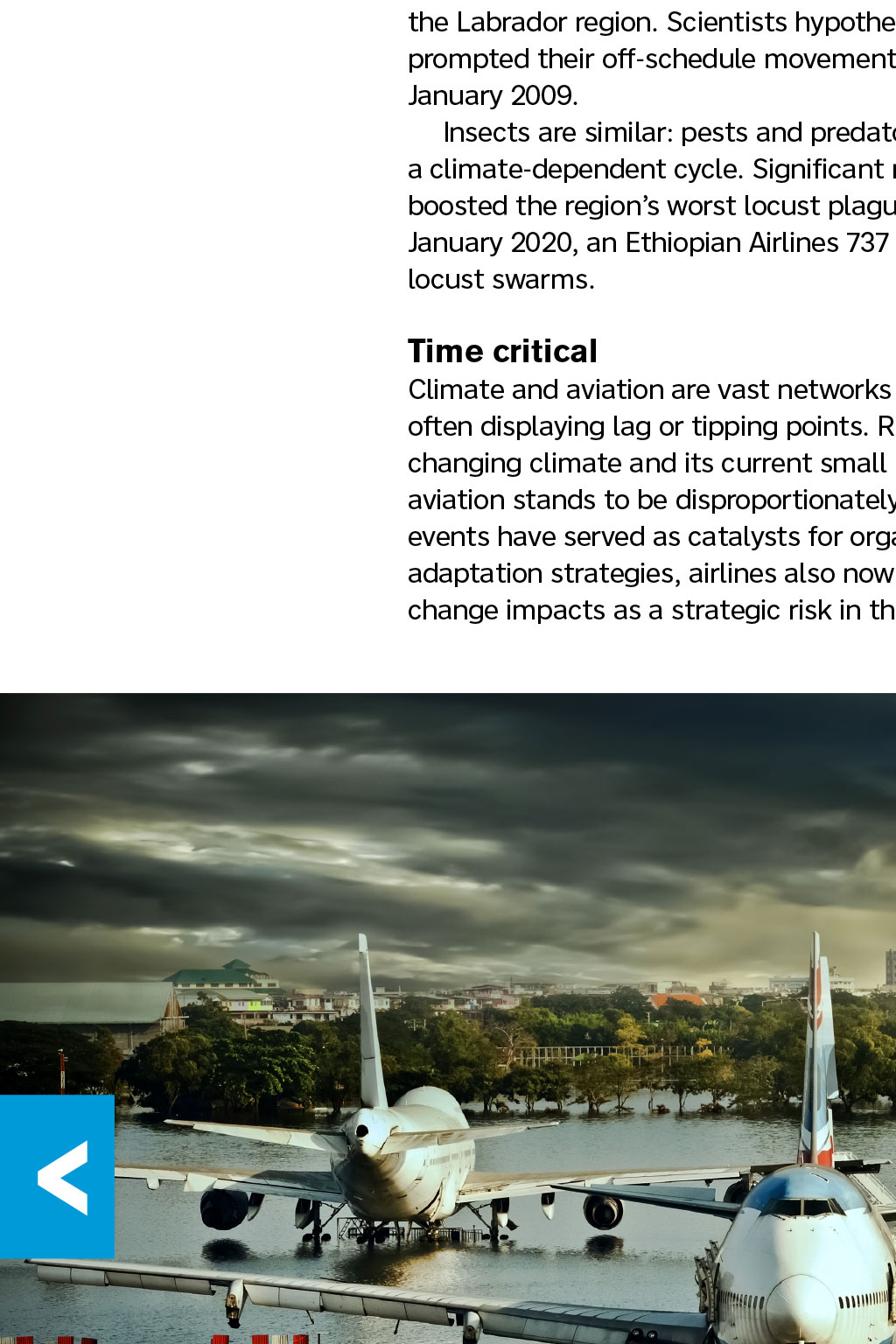
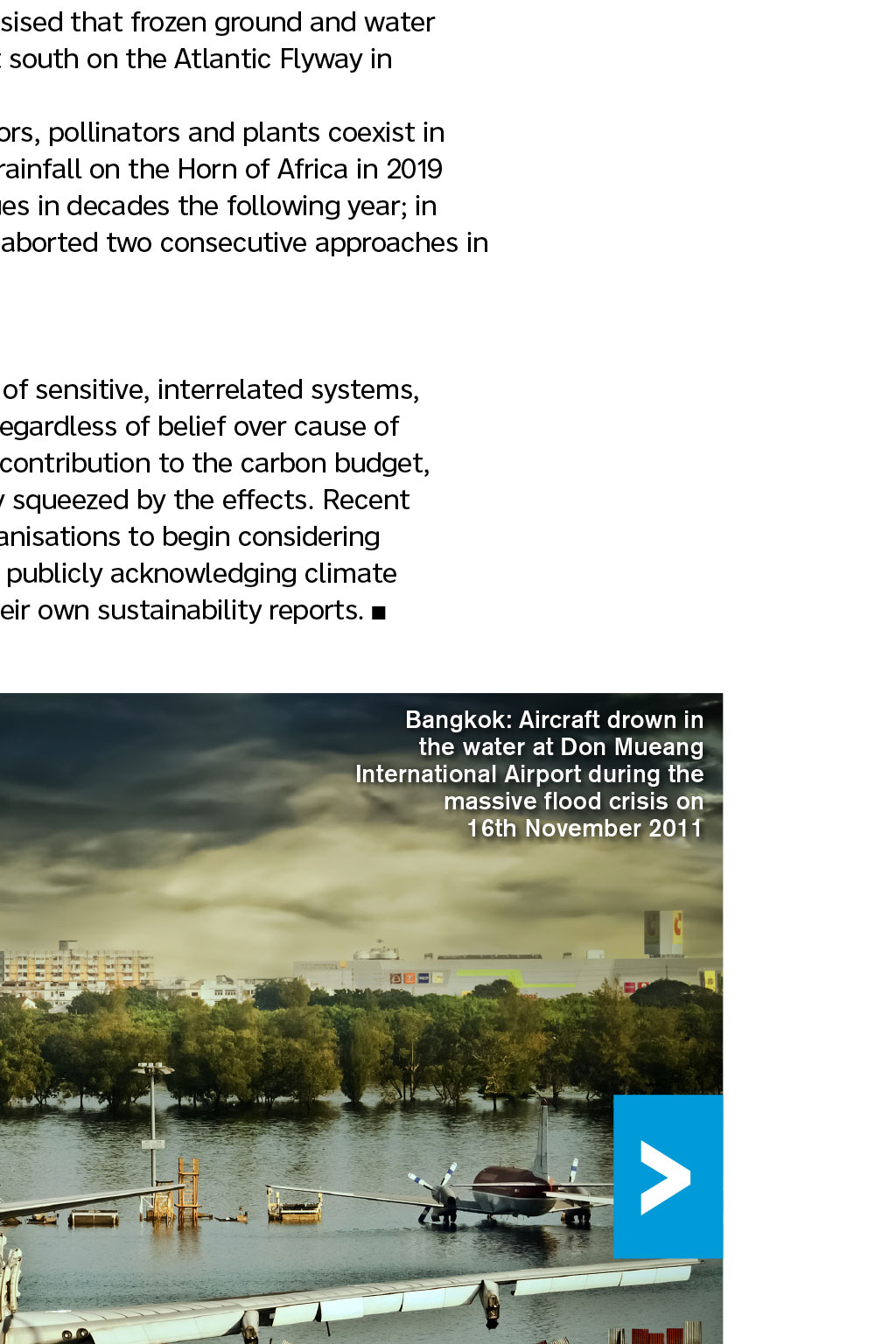
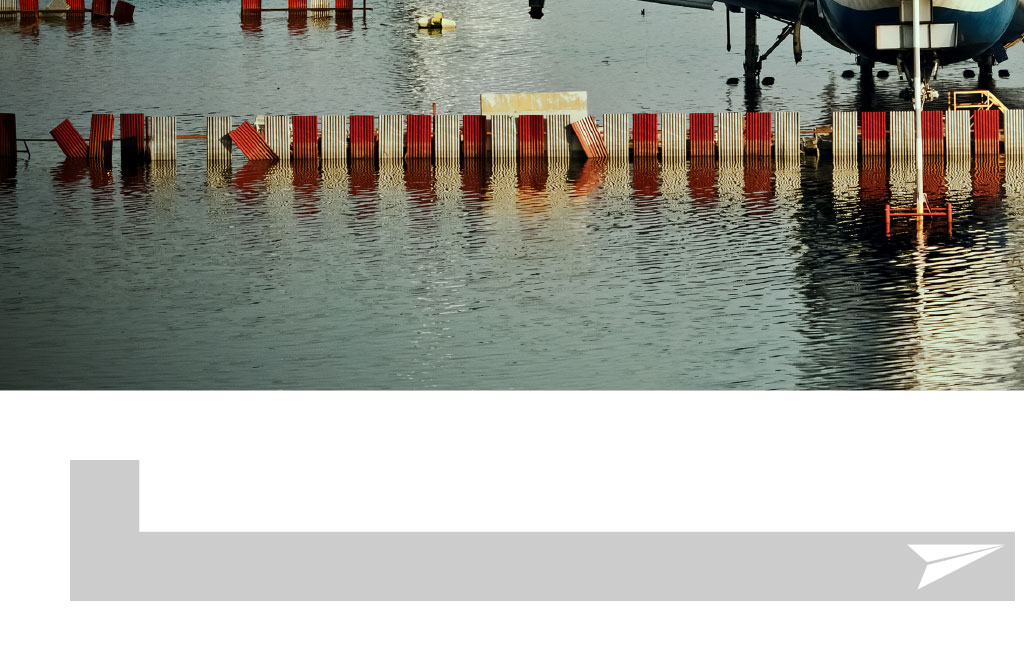
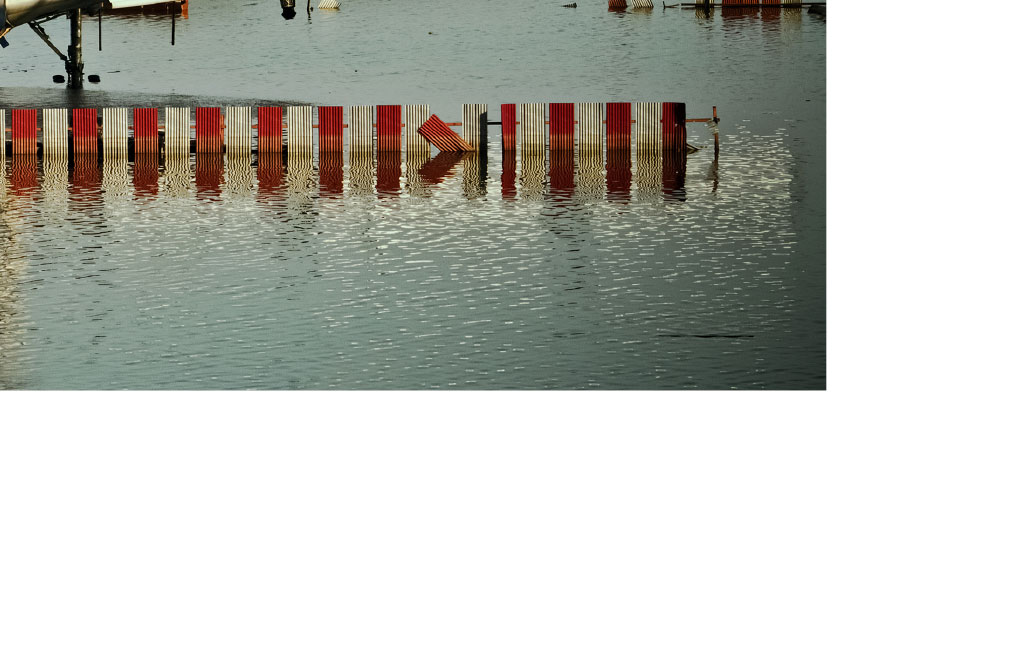




















ANGE The empire strikes back The effects of climate change on aviation By Captain Robin Evans, Senior Log Contributor At 2019 peak, aviation emitted 915m tonnes of CO2 2.1% of the global, human-emitted 43bn tonne total, accounting for 12% of the transport sector. Though dwarfed by many industries, this remains significant because of forecast industry growth and decarbonising difficulty. Besides contributing to climate change, aviation is also starting to suffer because of it, as revealed by the growing field of climate change impacts upon aviation. Its very much a two-way interaction, explains Dr Paul Williams, Professor of Atmospheric Science at the University of Readings Department of Meteorology, who has specialised in climate research for more than 20 years. Most of the scientific work and academic interest so far has been on the effect of aviation on our climate. The opposite question is relatively new, though a rapidly growing topic and a very important one. When you were learning to fly, I was in the university library studying the atmosphere, turbulence and jet streams, all the phenomena in the fluid that aircraft fly through. I have recently been applying that knowledge to analyse what the impacts might be of climate change on your sector. Where my job differs slightly from a traditional academic is that I spend a lot of my time engaging directly with industry. Of the discovery that increased turbulence was on the cards, Williams is clear. To my mind, [it was] the defining moment that opened up a whole new field of academic research. This also resonates most with the travelling public who are only just becoming aware. Based on the large number of presentations I get invited to deliver at industry conferences, I would say there is a huge appetite for more knowledge of this topic. Williams refers to a statement by the World Meteorological Organization (WMO) after its 2017 Aeronautical Meteorology Scientific Conference. A changing climate scenario may render some of todays aerodrome, airspace and airframe design and operation standards inadequate in the years or decades to come. Using past climatological records alone as an indicator of future climate at an airport may be insufficient, given the rate at which the worlds climate is changing. He reflects: Like all UN agencies, the WMO is quite conservative; it doesnt say things lightly. A statement such as this is sobering and I think an acknowledgement from the highest echelons that climate change is going to have consequences for the way we fly. So, what is climate change doing to aviation? The answer is quite a lot, says Williams, identifying five areas: 1. Flood defence Airport defence conjures up Tel Avivs Iron Dome, but the Earth has enough ice to raise sea levels 64m through the East Antarctic (52m), West Antarctic (5m) and Greenland (7m) ice sheets. One metre of rise would dramatically redraw the map, with profound consequences for millions; the location of coastal airports heavily influenced by the population density of these areas. The Met Offices 2022 State of Climate Report reveals sea levels rising 3-5mm annually, double the rate of early last century. One recent study estimated the sea level rise of 2C warming would put 100 airports below sea level. A 2014 assessment identified 13 of the USAs largest airports (including Miami, San Francisco and Newark) with at least one runway within reach of a moderate-high storm surge. Baseline tide is a key factor: outside high tide, Hurricane Sandy closed La Guardia (5-20 elevation) for three days in 2012, inundating both runways. A one-in-500-year flood event in pre-industrial times is currently one in 25, and it is now believed that Sandy-like New York flooding will become a one-in-fiveyear event by mid-century. The notoriously flood-prone New Orleans Louis Armstrong (elevation 4) is second only to Amsterdam Schiphol in low elevation. In 2011, Bangkoks Don Mueang Airport (elevation 9) 40kms inland was submerged after heavy monsoon rain, with 747s pictured with landing gear underwater. In 2018, Typhoon Jebi showed that even new, highly engineered airports were vulnerable, inundating Kansai (elevation 17). Despite the due diligence required in its reclamation from Osaka Bay, floods closed one runway for 10 days and one terminal for 17. 2. Density altitude Every 3C of warming is equivalent to a 1% density reduction or raising airport elevation 300. Recall the flight cancellations because of extreme temperatures (48C) in Phoenix, Arizona in 2017 considered Americas hottest city, with summer 2020 the hottest and deadliest on record. Cities are particularly prone to the heat dome effect of high pressure keeping a lid on conditions beneath. A 2016 ICAO report warned of severe consequences for aircraft takeoff performance, where high altitudes or short runways limit the payload or even the fuel-carrying capacity. A 2017 study of 10 Greek island airports with an IAE-engine A320 performance model revealed a reduction in takeoff performance over several decades. Chios (15 elevation with a 1,511m runway and pre-pandemic 240,000 annual passengers) was most restricted, with an annual MTOM reduction of 133kg. Since 1988 service entry, the A320 has suffered a four-tonne payload reduction here. All others, with MTOM unaffected, saw an annual mean TODR increase in the order of several metres. In opposition to expectations at altitude, a general weakening of surface winds over decades the global stilling phenomenon has a related effect on takeoff performance. In the UK, the extremes of July 2022 are only the most recent: of the 10 hottest days on record, nine occurred since 1990, with the top five in the past decade. Disruption of operating envelopes is typical of the likely effects of climatic aviation shifts. The mitigation of rescheduling for cooler times of day is already common in regions of the world limited by density altitude, if not runway length. A storm overhead Nice airport More lightning has historically occurred by day than night, over the Tropics rather than Poles 3. Extreme weather events Recalling piston engines, the carburettor icing risk initially increases with air temperature, as warmer air holds more moisture. In turn, a warmer atmosphere increases a clouds generation of electrical fields, lightning considered a tracer for violent winds, hail and heavy rain. Theres a clear link between temperatures and lightning, so it stands to reason that, as we warm the atmosphere, well see more lightning strikes, says Williams. More lightning has historically occurred by day than night, over the Tropics rather than Poles, and in summer rather than winter. This is now understood to be changing. A 2021 study of Arctic lightning strike data revealed summer strikes have increased from 18,000 (2010) to 150,000 (2020), with temperatures above 65N latitude increasing by an average 0.3C over the same period. Meanwhile, studies focusing on the continental US indicated that every degree of warming would equate to an increase in annual lightning activity of 12% (Romps et al, University of California, 2014) and 10% (Price, Tel Aviv University, 2012) respectively. Separate from jet streams, atmospheric rivers are long bands of atmospheric moisture, extending between tropics and higher latitudes. Releasing large water volumes, they are linked to dramatic weather events, expected to be more intense in a warming climate. One such river, the Pineapple Express funnels water vapour from Hawaii to the US: the source of the November 2021 storms along the Pacific Northwest and into Canada. Months before, the region had experienced wildfires and the heat dome effect. Together, the phenomena match the scientific expectation for hotter, drier summers and wetter winters; and although single events cant be categorically pinned on climate change, studies confirm such events are more likely. 4. Modifying wind patterns WIlliams focus is particularly upon jet-stream and windshear effects; there is consensus from climate models that wind speeds at altitude will increase in future. The temperature differential between the Tropics and Arctic is what drives the North Atlantic jet stream. Amplified warming in the tropical upper troposphere, plus the Arctic now warming four times faster than anywhere else on Earth because of the albedo (reflectivity) change of sea ice loss, is brought to bear on cruise altitudes. Williams work has shown that when modelling flight time against probability, a doubled CO2 scenario pushes eastbound crossings towards the fastest end of the distribution; and westbound towards the slowest. In this scenario, the likelihood of a sub 5h20m eastbound transatlantic flight more than doubles from 3.5% to 8.1%, with the westbound likelihood of exceeding 7hrs nearly doubling from 8.6% to 15.3%. Our studies have shown that twice as many flights will experience very fast eastbound crossings in the years to come, he reveals. Subsonic eastbound records are getting faster: JFK-LHR 5h16m (Jan 2015) 5h13m (Jan 2018) and 4h 56m (Feb 2020). In the third case, the strong jet stream was also responsible for powering Storm Ciara, two other transatlantic flights exceeding the previous record. Says Williams: Im not saying climate change has necessarily caused these records to be broken, but it is certainly consistent with what we expect. While westbound crossings experience an opposing effect, the headwind penalty exceeds the corresponding eastbound tailwind. Extrapolated to all transatlantic traffic (600 daily crossings) gives an extra 2,000 hours airborne annually. Williams work also helped motivate the 2022 NATS policy change on removing the North Atlantic Organised Track Structure (OTS) at and below FL330. One study of the original setup showed aircraft were forced to fly hundreds of unnecessary kilometres. Another airline-sponsored study demonstrated that every minute saved over the ocean equated to 51. Our quantification of the possible savings certainly helped to build a strong case, he says. READ MORE Research and reporting 5. CAT out of the bag All crossings can expect more turbulence; studies reveal the North Atlantic jet stream at cruising altitudes has become 15% more sheared since satellites began observations in the 1970s. A 2017 study in Advances in Atmospheric Sciences found that doubling CO2 levels would increase North Atlantic CAT at FL390 by 149%. Williams & Joshi (2013) show a range of 21 CAT measures diagnosed from climate simulations are significantly modified if CO2 is doubled. The change varies: the equator shows a light reduction, with the largest increases expected in the regions containing the most flown routes. At cruise altitudes within 50-75N, most measures show a 40-170% increase in airspace volumes containing moderate CAT. The forecasting methods have been tested using aircraft measurements and found to work, explains Williams, but were talking about increases over decades. While exact figures vary according to model and scope, they all agree that bumpier transatlantic flights can be expected by mid-century. Its quite sobering; a clear trend consistent among different data sets, says Williams, adding that a given increase in shear doesnt equate directly to turbulence. Its more complicated than that; turbulence generation is a nonlinear effect. Other effects Beyond Williams work, there are at least two other effects yet to receive analysis on an equivalent scale. One is the number of Mediterranean outstations requiring frostbuster (small, manual de-icing) equipment at least one carrier now contracting this in Cyprus. The second is bird activity: scientists having already made the parallel that displaced migration, nesting and food is akin to the canary in the mine. Flyways are the migration corridors spanning continents, the migratory Canada geese threat synonymous with Chesley Sullenberger. The feathers recovered from his engines contained the deuterium signature of the latitude of their last moult: the Labrador region. Scientists hypothesised that frozen ground and water prompted their off-schedule movement south on the Atlantic Flyway in January 2009. Insects are similar: pests and predators, pollinators and plants coexist in a climate-dependent cycle. Significant rainfall on the Horn of Africa in 2019 boosted the regions worst locust plagues in decades the following year; in January 2020, an Ethiopian Airlines 737 aborted two consecutive approaches in locust swarms. Time critical Climate and aviation are vast networks of sensitive, interrelated systems, often displaying lag or tipping points. Regardless of belief over cause of changing climate and its current small contribution to the carbon budget, aviation stands to be disproportionately squeezed by the effects. Recent events have served as catalysts for organisations to begin considering adaptation strategies, airlines also now publicly acknowledging climate change impacts as a strategic risk in their own sustainability reports. Bangkok: Aircraft drown in the water at Don Mueang International Airport during the massive flood crisis on 16th November 2011 READ MORE RESEARCH AND REPORTING Climate change risks for European aviation, Eurocontrol summary document, 2021 eurocontrol.int/publication/eurocontrol-study-climate-change-riskseuropean-aviation Understanding the impact of climate change on aviation eurocontrol.int/article/understanding-impact-climate-change-aviation The impacts of climate change on Greek airports, Gratton et al, 2020 link.springer.com/article/10.1007/s10584-019-02634-z Global Stilling ec.europa.eu/research-and-innovation/en/horizon-magazine/stillingglobal-wind-speeds-slowing-1960 Revealed: how climate breakdown is supercharging toll of extreme weather Damian Carrington, The Guardian, 4 Aug 2022. theguardian.com/environment/2022/aug/04/climate-breakdownsupercharging-extreme-weather Vapor storms are threatening people and property, Francis, J, American Scientific, 2021 scientificamerican.com/article/vapor-storms-are-threatening-peopleand-property/ Transatlantic time differentials Williams (2016), Irvine et al (2016) wired.co.uk/article/london-to-new-york-flight-time-record Clear-Air turbulence in a Changing Climate, Williams and Joshi, 2013 met.reading.ac.uk/~williams/publications/WilliamsJoshi_Chapter23.pdf A rope tornado above the runway and air traffic control tower Flying through the storm Gran Canaria, Canary Island, aircraft landing on the runway Monsoon thunderstorm over airport control tower Flying a passenger plane into storm clouds